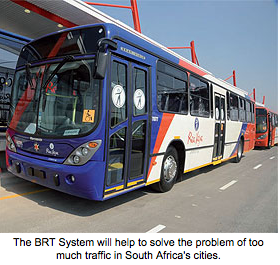BRT - GOING SAFER AND FASTER
BRT - GOING SAFER AND FASTER sadminThousands of people in Johannesburg travel long distances across the city every day to get to work and back. They will now be able to get there safer and faster with the Bus Rapid Transport system. The  system is called Rea Vaya, which is SeSotho for 'we are going'.
system is called Rea Vaya, which is SeSotho for 'we are going'.
The Bus Rapid Transit (BRT) System is aimed at upgrading the public transport system in South Africa's main cities ahead of the 2010 FIFA World Cup.
Cities which will get the BRT system are Johannesburg, eThekwini (Durban), Tshwane (Pretoria), Cape Town and Nelson Mandela Metro (Port Elizabeth).
These cities will continue to reap the benefits long after the World Cup has come and gone. There will be less traffic, which means less accidents. People will also get to their workplaces faster.
Phases
The construction of the first phase of the Rea Vaya bus route has been completed. It includes special bus lanes on the major highways and city streets, as well as bus stations and ticketing centres.
- The first phase, Phase 1A, started at the end of August. It runs between Regina Mundi Church in Thokoza Park, Soweto and Ellis Park.
- The route will pass stations at Orlando Stadium, Westgate, Chancellor House, Beyers Naude Square, Carlton Centre, Fashion Square, Johannesburg Art Gallery, and the Doornfontein campus. It will drop passengers at the Ellis Park North and Ellis Park East stations.
- The second phase, Phase 1B, will run from Soweto past the universities of Johannesburg and the Witwatersrand, through to Sandton.
- The third phase, Phase 1C, will run in an east-west direction, from Alexandra to Cresta.
Buses
Some 143 buses have been put into operation in Phase 1A. They travel 25,5 kilometres and stop at 27 stations. It is expected that more than 69 000 passengers will travel on the buses every day.
Two kinds of buses are used on the Rea Vaya BRT routes. The bigger buses, called trunk buses, can carry 112 passengers. They have doors on the right-hand side and run in the special bus lanes.
The smaller buses have doors on both sides and can carry 75 passengers. They travel on the special BRT routes and on normal routes.
Control room
A control room checks security, traffic lights and road conditions 18 hours a day. If there is a breakdown, mechanical teams will be sent out immediately to remove the bus from the lane.
The control room also gives information to passengers. A voice-over system is used to help passengers who cannot read and those who are blind.
To limit delays, traffic lights on the BRT routes are activated to turn green as soon as the bus is near. This is done through the Rea Vaya control room in Martindale, Johannesburg.
A satellite tracking system ensures that the buses are exactly on time.
- Mbulelo Baloyi